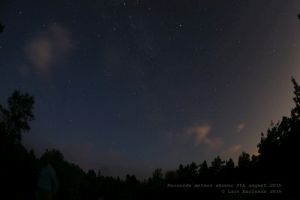|
Advertisement / Annons: |
Astronomy CalculationsContent: |
Sky background magnitude |
|
|
One big problem when doing astro photographing is the light polluted sky. The light pollution can be expressed in magnitude per arc second area, arcsec2 . With the usual Sky Brightness meters you can see what light pollution values you have for the moment, the goal of this calculation is to see what light pollution you had on your old photos.
To find a value of the Light pollution we need a reference star, it will be better results if the reference star is high up in the sky and free from surrounding stars, close to Zenith. On the other hand, when examine old photos you take a ref star in the center of the photo whatever the camera pointing to. The wavelength where the magnitude is related to shall correspond to the filter you have on the camera. The visual wavelength band is the most common, it's not the full visual spectra, it's more narrow, the mv (magnitude visual) is centered at 550 nm and 160 nm wide. The human eye is most sensitive in the green / yellow spectra during low light condition then this will be wrong to use the blue spectra. In books, at least earlier ones the magnitude is only denoted mag, I thought that must be mv (visual). After I got answer on my question to my earlier teacher prof Gösta at the University, he told me that's normally a blue spectra because of the earlier photo technique. The color system in astronomy is complicated, I can read that more then 200 different system exists. Better to use a star catalog where the magnitude data are more in detail which spectra it belongs to. I normally use CdC (Sky Chart), a star chart software to find the stars magnitudes, just right click on the star and an info box comes up.
If you have a color camera you can use the green channel as a rough estimation of mv. We also need to know something about the telescope and camera to get this correct, we must know how many arcsec2 one pixel cover, we get that from the pixel scale.
The image you take your data from must be dark and bias calibrated. Use the center of the sensor, then less problem with vignetting. Because the star normally covers many pixels you must add up all of them that the stars covers. But first you must subtract the background, normally done by automatic in your astro tool you use.
Example:
Then: These add up to 450 ADU star flux.
Note: If you have a color camera it's little bit more complicated. I think it's best to use the CFA format, calibrate it with dark and bias and then do a demosaic and keep the green channel, not debayer.
Some software give two green channels when demosaicing which is the correct way to do it, then just average them together.
If you find the math behind this interesting: msky = 5 / 2 * log10 ( Iref / Isky ) + mref Where Isky = IskyADU / pixelscale2 |

|
Type in your dataIt start to calculate as soon you change or write new figures in the white or dark red boxes. Do not exceed the maximum number of characters, delete characters if necessary.
Note: |
My own result:
|
|||||||||||||||||||||||||||||||||||||||||||||||||||||||||||||
| Go Back |